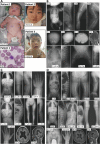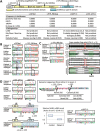Clinical and molecular findings in three Japanese patients with N-acetylneuraminic acid synthetase-congenital disorder of glycosylation (NANS-CDG)
- PMID: 36224347
- PMCID: PMC9556533
- DOI: 10.1038/s41598-022-21751-x
Clinical and molecular findings in three Japanese patients with N-acetylneuraminic acid synthetase-congenital disorder of glycosylation (NANS-CDG)
Abstract
We report clinical and molecular findings in three Japanese patients with N-acetylneuraminic acid synthetase-congenital disorder of glycosylation (NANS-CDG). Patient 1 exhibited a unique constellation of clinical features including marked hydrocephalus, spondyloepimetaphyseal dysplasia (SEMD), and thrombocytopenia which is comparable to that of an infant reported by Faye-Peterson et al., whereas patients 2 and 3 showed Camera-Genevieve type SMED with intellectual/developmental disability which is currently known as the sole disease name for NANS-CDG. Molecular studies revealed a maternally inherited likely pathogenic c.207del:p.(Arg69Serfs*57) variant and a paternally derived likely pathogenic c.979_981dup:p.(Ile327dup) variant in patient 1, a homozygous likely pathogenic c.979_981dup:p.(Ile327dup) variant caused by maternal segmental isodisomy involving NANS in patient 2, and a paternally inherited pathogenic c.133-12T>A variant leading to aberrant splicing and a maternally inherited likely pathogenic c.607T>C:p.(Tyr203His) variant in patient 3 (reference mRNA: NM_018946.4). The results, together with previously reported data, imply that (1) NANS plays an important role in postnatal growth and fetal brain development; (2) SMED is recognizable at birth and shows remarkable postnatal evolution; (3) NANS-CDG is associated with low-normal serum sialic acid, obviously elevated urine N-acetylmannosamine, and normal N- and O-glycosylation of serum proteins; and (4) NANS-CDG is divided into Camera-Genevieve type and more severe Faye-Peterson type.
© 2022. The Author(s).
Conflict of interest statement
The authors declare no competing interests.
Figures



Similar articles
-
Oral sialic acid supplementation in NANS-CDG: Results of a single center, open-label, observational pilot study.J Inherit Metab Dis. 2023 Sep;46(5):956-971. doi: 10.1002/jimd.12643. Epub 2023 Jul 8. J Inherit Metab Dis. 2023. PMID: 37340906
-
NANS-CDG: Delineation of the Genetic, Biochemical, and Clinical Spectrum.Front Neurol. 2021 Jun 7;12:668640. doi: 10.3389/fneur.2021.668640. eCollection 2021. Front Neurol. 2021. PMID: 34163424 Free PMC article.
-
NANS-CDG: Expanding clinical insights with a novel patient with novel variants.Am J Med Genet A. 2024 Oct;194(10):e63721. doi: 10.1002/ajmg.a.63721. Epub 2024 Jun 1. Am J Med Genet A. 2024. PMID: 38822623
-
COG1-congenital disorders of glycosylation: Milder presentation and review.Clin Genet. 2021 Sep;100(3):318-323. doi: 10.1111/cge.13980. Epub 2021 May 13. Clin Genet. 2021. PMID: 33960418 Review.
-
What is new in CDG?J Inherit Metab Dis. 2017 Jul;40(4):569-586. doi: 10.1007/s10545-017-0050-6. Epub 2017 May 8. J Inherit Metab Dis. 2017. PMID: 28484880 Review.
Cited by
-
Neurodevelopmental defects in human cortical organoids with N-acetylneuraminic acid synthase mutation.Sci Adv. 2023 Nov 24;9(47):eadf2772. doi: 10.1126/sciadv.adf2772. Epub 2023 Nov 24. Sci Adv. 2023. PMID: 38000033 Free PMC article.
-
Clinical and Molecular Features of Patients With Congenital Disorders of Glycosylation in Japan.JIMD Rep. 2025 Apr 4;66(3):e70011. doi: 10.1002/jmd2.70011. eCollection 2025 May. JIMD Rep. 2025. PMID: 40191061 Free PMC article.
-
Diabetes mellitus with severe insulin resistance in a young male patient with a heterozygous pathogenic IRS1 frameshift variant.Clin Pediatr Endocrinol. 2024;33(2):87-93. doi: 10.1297/cpe.2023-0081. Epub 2024 Feb 23. Clin Pediatr Endocrinol. 2024. PMID: 38572380 Free PMC article.
References
Publication types
MeSH terms
Substances
LinkOut - more resources
Full Text Sources

